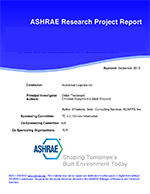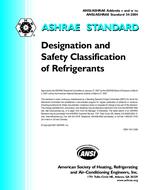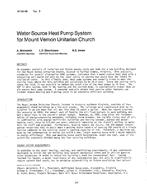Non-azeotropic refrigerant mixtures (narms) exhibit temperature variation during constant pressure phase change processes, such as condensation and evaporation. The temperature variation during phase change can be used beneficially in applications where the external heat source and sink temperature also vary. This concept is motivated by the potential savings in energy consumption which is expected of refrigerant mixtures. The optimum combination of various binary-refrigerant mixtures for a domestic refrigerator under specified operating conditions was thermodynamically determined. The performance of a Magic Chef Model mcbr270s mini-fridge (available in our laboratories), was simulated to obtain the optimized binary mixture ratios. The overall heat transfer coefficient values for the evaporator, the condenser and the suction line heat exchanger (slhx) were chosen for the simulations. Applying the constrained optimization theory, the optimum mixture fraction of the refrigerants was determined for given sets of binary refrigerants. Two refrigerant pairs were selected based upon their thermophysical and environmental properties like heat of vaporization, global warming potential (gwp) and ozone depletion potential (odp). The R-125/R-134a and R-32/R-134a mixtures were chosen as the binary components for simulation in a 50 W (0.047BTU/s) duty vapor-compression cycle. Specifically the combinations R-125/R-134a and R-32/R-134a were chosen as the binary components for simulation in a vapor-compression cycle as found in a magic chef model mcbr270s mini-fridge. In addition, the combination R-12/R-114 was also considered for an industrial scale 20 kW (18.96 BTU/s) duty vapor-compression refrigeration cycle. For each pair, constrained optimization studies were carried out to determine the optimum ratios of the refrigerants to provide the maximum coefficient of performance (COP) under given operating conditions. While the pair R-125/R-134A appeared to be a poor match for the mini-fridge we considered (both computationally and experimentally), the pair R-32/R-134A showed promise as a refrigerant mixture.
Citation: 6th International Conference on Energy Research and Development, State of Kuwait, March 14–16, 2016
Product Details
- Published:
- 2016
- Number of Pages:
- 8
- Units of Measure:
- Dual
- File Size:
- 1 file , 2.6 MB
- Product Code(s):
- D-ICER16-37


